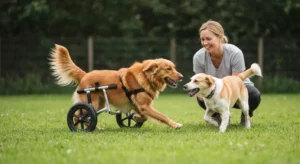As a certified animal behaviorist and professional trainer with over a decade of experience, I’ve seen it all. I’ve worked with countless well-meaning pet owners who love their animals dearly but are unknowingly making their training journey harder than it needs to be. The good news is that training isn’t about dominance or being the “alpha”; it’s about clear communication, building trust, and creating a joyful partnership with your pet.
Frustration during training often stems from a few common, easily correctable misunderstandings about how our pets learn. If you feel like you’re stuck in a loop of repeated commands and unwanted behaviors, you are not alone. This guide is designed to shed light on the most frequent pet training mistakes I encounter and, more importantly, give you the practical, expert-backed strategies to fix them. By shifting your approach, you can transform training from a chore into a rewarding experience that deepens your bond for years to come.
-
Mistake #1: Inconsistency in Rules and Cues
The Mistake: One of the most common hurdles in any multi-person household is a lack of consistency. Mom lets the dog on the couch, but Dad yells when he sees her there. One person says “Down” when they want the dog to lie down, while another uses “Down” to mean “get off the counter.” The cat is allowed to beg at the table on weekends but not on weekdays. To a pet, this is incredibly confusing.
The ‘Why’: Animals, especially dogs, thrive on predictability and clear patterns. When the rules constantly change depending on who is in the room or what time of day it is, your pet can’t figure out what you want. This doesn’t teach them to be “good”; it teaches them that the rules are arbitrary. This confusion leads to anxiety and a breakdown in learning. They may start “testing” boundaries constantly to see what they can get away with in that specific moment, or they may shut down altogether, unsure of how to behave to earn praise. Inconsistent cues (using different words for the same action) are just as damaging, as your pet never learns to reliably associate a single sound with a specific behavior.
The ‘How’ to Fix It:
1. Hold a Household Meeting: Get everyone who interacts with the pet in the same room. This includes spouses, children, roommates, and even regular visitors like a grandparent. Decide on a single, unified set of house rules. Is the pet allowed on the furniture? Are they fed from the table? Where do they sleep?
2. Create a “Command Dictionary”: Agree on one—and only one—verbal cue and hand signal for each behavior. For example:- “Sit”: The act of putting their rear on the floor.
- “Down”: The act of lying down completely.
- “Off”: The cue to get off of furniture or a person.
- “Leave It”: The cue to ignore an item on the ground.
3. Write It Down and Post It: Create a physical cheat sheet with the house rules and the official command list. Post it on the refrigerator or another central location. This serves as a constant reminder for everyone and helps keep guests in the loop.
4. Commit to 100% Consistency: This is the hardest part. Everyone must agree to enforce the rules every single time. If the rule is “no paws on the counter,” then the pet must be corrected (by redirecting them) every single time, by every single person. This clarity is the fastest path to a well-behaved pet. -
Mistake #2: Relying on Punishment Instead of Reinforcement
The Mistake: When a puppy has an accident or a cat scratches the furniture, a common human reaction is to punish. This often involves yelling, swatting with a newspaper, using a spray bottle, or employing aversive tools like shock, prong, or choke collars. The owner believes this will teach the pet that the behavior is “bad.”
The ‘Why’: From a modern, science-based behavior perspective, punishment is an ineffective and often harmful training tool. Here’s why: It doesn’t teach your pet what you want them to do instead. A dog punished for barking out the window learns that your presence is scary when the mail carrier arrives; it doesn’t learn to be quiet. Punishment creates fear, anxiety, and stress, which are counterproductive to learning. Most importantly, it can severely damage your bond. Your pet may learn to fear you, not the act itself. This can lead to a host of other problems, including hiding, submissive urination, and even defensive aggression when they feel cornered.
The ‘How’ to Fix It:
1. Embrace Positive Reinforcement: This is the gold standard of modern animal training. Reward the behaviors you want to see more of. If your dog sits politely instead of jumping, reward them with a high-value treat and praise. If your cat uses the scratching post instead of the couch, give them affection and a special treat right after. You get more of what you reinforce.
2. Manage the Environment to Prevent Mistakes: Set your pet up for success. If your puppy is chewing shoes, don’t leave shoes out. Put them in a closet. Use baby gates to block off areas where they tend to have accidents. Provide multiple, attractive scratching posts for your cat right next to the furniture they target. Management is proactive training.
3. Redirect and Teach an Alternative Behavior: When your pet performs an unwanted behavior, calmly interrupt them and redirect their attention to something appropriate. If your puppy starts nipping at your hand, yelp “Ouch!” loudly, remove your hand, and immediately offer them a chew toy. When they chew the toy, praise them enthusiastically. You are teaching them, “Don’t do this, do this instead.” -
Mistake #3: Bad Timing with Rewards and Consequences
The Mistake: An owner asks their dog to “Sit.” The dog sits, then immediately stands up as the owner fumbles for a treat. The owner gives the treat. Another common example: An owner comes home to find a puddle on the floor and proceeds to scold the dog, pointing at the spot.
The ‘Why’: An animal’s brain works in the immediate present. They associate a reward or a punishment with whatever they were doing in the 1-2 seconds preceding it. In the first example, the dog wasn’t rewarded for sitting; it was rewarded for standing up. This is why owners get frustrated when their dog offers a “Sit” for only a split second. In the second example, the dog has no possible way to connect the owner’s anger with the act of urinating that happened minutes or hours ago. All it learns is that its owner is unpredictable and scary when they walk through the door.
The ‘How’ to Fix It:
1. Master the 1-Second Rule: Your reward must be delivered almost immediately after the desired behavior occurs. Have your treats ready in your hand or a treat pouch before you give the cue. The moment your dog’s rear hits the floor for a “Sit,” the treat should be on its way to their mouth.
2. Use a Marker Word or Clicker: A marker is a powerful tool for improving timing. A marker is a unique sound (like the word “Yes!” or a click from a clicker) that “marks” the exact moment the pet does something right. The sound is followed by the reward (the treat).
Example: You say “Sit.” The instant the dog sits, you say “Yes!” in an upbeat tone, and then you deliver the treat. The dog learns that “Yes!” means “What I was just doing earned me a reward.” This bridges the gap between the behavior and the treat, allowing for perfect timing even if you need a second to grab the food.
3. Never Punish After the Fact: If you discover an accident or a chewed-up item, it’s too late to “teach a lesson.” Any anger or punishment is pointless and damaging. Simply clean up the mess without a word to your pet. Then, ask yourself: “How can I manage the environment better to prevent this from happening again?” The responsibility is on you to prevent the mistake, not on the pet to understand your retroactive anger. -
Mistake #4: Making Training Sessions Too Long or Too Difficult
The Mistake: A new owner is excited to train their puppy and drills “Sit,” “Stay,” and “Down” for 45 minutes straight. Or, they take their dog who just learned “Stay” in the living room to a busy park and expect them to hold it for two minutes while other dogs play nearby.
The ‘Why’: This is a concept called “over-facing,” and it’s a major cause of training burnout for both pets and people. A pet’s attention span, especially a young one’s, is short. Long, repetitive sessions become boring and frustrating. When a task is too difficult (like the “Stay” at the park), the pet is set up to fail. This failure leads to the owner getting frustrated and the pet becoming stressed and anxious. Eventually, the pet may develop a negative association with training itself, wanting to avoid it altogether.
The ‘How’ to Fix It:
1. Think in Minutes, Not Hours: Keep your formal training sessions short, upbeat, and fun. For most pets, three to five 5-minute sessions spread throughout the day are far more effective than one long 30-minute session. Always end on a positive note, with a behavior your pet can successfully perform, so they finish feeling confident.
2. Break Behaviors into Tiny Pieces (Shaping): Don’t try to teach the entire “go to your bed” behavior at once. Start by rewarding your dog for just looking at the bed. Then, for taking one step toward it. Then for putting one paw on it, then two, and so on. This process, called “shaping,” builds confidence and keeps the pet engaged.
3. Master the “3 D’s” of Difficulty: When you want to make a behavior more challenging (a process called “proofing”), only increase one variable at a time. The 3 D’s are:- Duration: How long the pet holds the position (e.g., a “Stay” for 3 seconds, then 5, then 10).
- Distance: How far away you are from the pet (e.g., asking for a “Sit” from 1 foot away, then 3 feet, then across the room).
- Distraction: The competing elements in the environment (e.g., practicing “Heel” in a quiet hallway before trying it on a quiet street, and long before trying it at a pet store).
Only increase one ‘D’ at a time while keeping the other two easy. For instance, practice a very short-duration “Stay” with a big new distraction.
-
Mistake #5: Misinterpreting or Ignoring Your Pet’s Body Language
The Mistake: An owner sees their dog yawning and lip-licking while a child hugs them and thinks the dog is just tired or “giving kisses.” A cat owner forces their pet, whose ears are flat and whose tail is twitching furiously, to be held by a visitor. They miss the clear signs of distress until the pet growls, hisses, or snaps, which they then label as “sudden” or “unpredictable” aggression.
The ‘Why’: Your pet is communicating with you constantly through their body language. These signals are their way of saying, “I’m uncomfortable,” “I’m scared,” or “I need space.” Ignoring these early, subtle warnings is like ignoring the smoke before the fire. When a pet’s quiet requests for space are ignored, they feel they have no choice but to escalate their communication to something you can’t ignore, like a growl or a bite. This is not aggression out of nowhere; it’s a predictable outcome of unheeded communication. Punishing a growl is especially dangerous, as it teaches the pet to skip the warning and go straight to a bite next time.
The ‘How’ to Fix It:
1. Become a Student of Body Language: Your most important job as a pet owner is to learn to speak their language. Actively study and learn to recognize stress signals.
For dogs, look for: yawning when not tired, lip licking, “whale eye” (showing the whites of the eyes), tucked tail, pinned ears, a tense body, and shaking off as if wet.
For cats, look for: a low, twitching tail; flattened “airplane” ears; dilated pupils; a crouched or tense posture; and vocalizations like hissing or growling.
2. Be Your Pet’s Advocate: When you see these stress signals, your job is to intervene immediately. Create space. Ask the child to stop hugging the dog. Tell the visitor to let the cat go. Move your dog away from the other dog that is making them nervous. Advocating for your pet builds immense trust. They learn that you understand them and will keep them safe.
3. Respect the Growl: A growl is not a challenge to your authority. It is a desperate plea for space and a critical warning signal. Never punish a growl. Instead, thank your pet for the warning, identify the trigger that caused the growl, and immediately remove your pet (or the trigger) from the situation. Then, you can create a training plan to help them feel more comfortable around that trigger in the future, from a safe distance. -
Mistake #6: Assuming a Skill is Mastered After One Success (Lack of Proofing)
The Mistake: A dog has a rock-solid “Come” command inside the house. The moment a squirrel appears, the owner calls them, but the dog takes off. The owner gets angry, thinking the dog is being “stubborn” or “disobedient.” They believe that once a command is learned in one place, it should work everywhere.
The ‘Why’: This is perhaps the biggest misunderstanding about how animals learn. Pets do not generalize well. Just because your dog knows “Sit” in your living room does not mean they understand what “Sit” means in the context of the backyard, the vet’s office, or the pet store. To them, each new environment with its unique sights, sounds, and smells is a completely different picture. The command gets lost in the noise of the new, highly distracting environment. They aren’t being stubborn; their brain is simply overwhelmed by the new stimuli, and the living room “Sit” hasn’t been connected to the park “Sit.”
The ‘How’ to Fix It:
1. Systematically “Proof” Every Behavior: Proofing is the process of teaching your pet that a cue means the same thing regardless of the environment. Once a behavior is 100% reliable in a quiet, familiar location, you must start practicing it in new places.
2. Go Back to Kindergarten: When you enter a new, more distracting environment, you must lower your expectations significantly. Be prepared to start over as if it’s the first time you’re teaching the behavior. This might mean using a food lure again, rewarding for a less-than-perfect attempt, and using much higher-value treats (like chicken or cheese instead of kibble) to compete with the distractions.
3. Use a Long Line for Safety: When proofing crucial safety commands like “Come” or “Stay” in an unfenced outdoor area, always use a long line (a 20-50 foot lightweight leash). This is your safety net. It allows your dog to have freedom while ensuring you have control. It prevents them from learning the dangerous lesson that they can ignore your recall cue and run off. You can gently reel them in if they get distracted, preventing the “self-reinforcement” of chasing a squirrel. Never let a dog off-leash in an unsecured area until their recall has been proofed and is 99% reliable in that specific environment.
Training your pet is one of the most significant investments you can make in your relationship. It’s a journey filled with learning opportunities—for both of you. Don’t be discouraged if you’ve been making some of these mistakes. The most important thing is your willingness to learn and adapt. By focusing on consistency, positive reinforcement, and clear communication, you are not just teaching commands; you are building a foundation of trust and mutual understanding that will last a lifetime.












